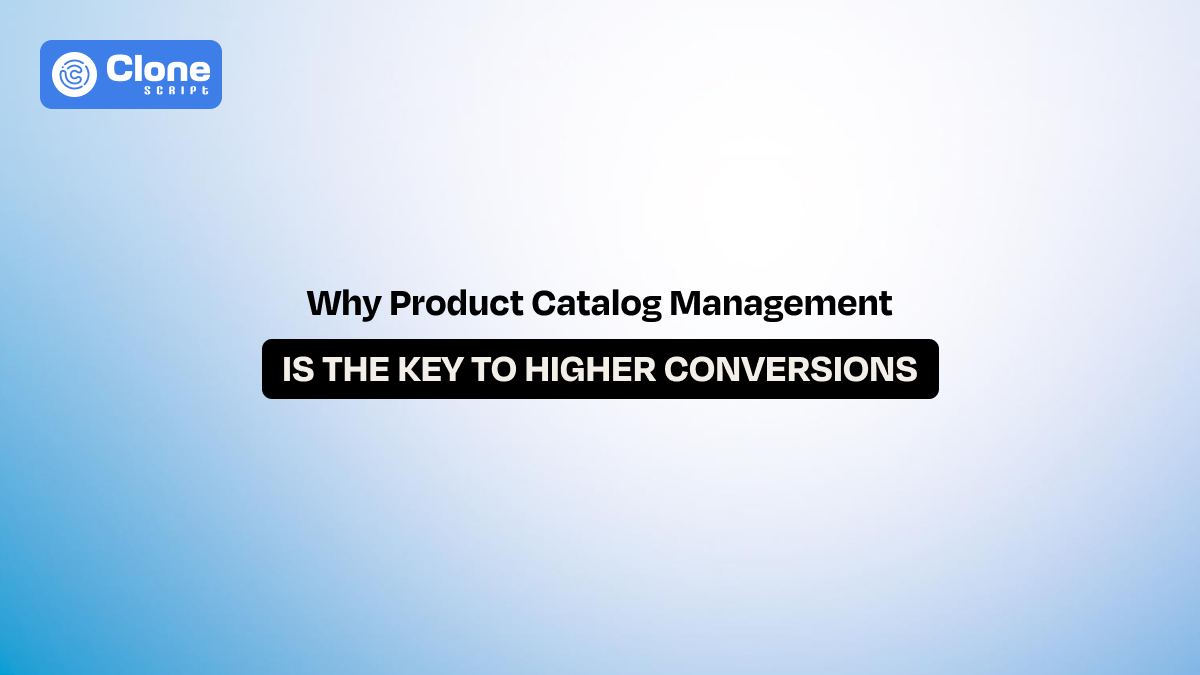Why Product Catalog Management Is the Key to Higher Conversions
In e-commerce, customers are very clever, fast, and they have to be. To help them in their purchase decision, the business has to be present accordingly. Product catalog management is the right way to present as a professional brand.
Look, despite having the best quality of products in any of the segments, there are only 3 seconds to win the customer’s trust. If not, then don’t think of being the next e-commerce giant.
In this article, we’ll explore the power of catalog management, practical strategies for improvement, and why professional services can take your business to the 1st rank.
Fix the root cause of high bounces. Learn to leverage Product Catalog Management for 100% data accuracy, rich attributes, and a flawless customer journey. Start the audit.
What Is Product Catalog Management?
Think of your product catalog as the heart of your online business. Product catalog management is the process of organizing, maintaining, and optimizing all your product information across every sales channel. It’s not just about listing items; it’s about presenting them in a way that inspires confidence, reduces friction, and encourages purchases.
A properly managed catalog ensures your customers can quickly:
-
Understand what a product is and how it benefits them.
-
Compare options without confusion.
-
Make a confident buying decision.
Key elements of catalog management include:
-
Product Descriptions: Through clear, informative, and persuasive text, users can understand what the product is about and how they can benefit from it.
-
Pricing Information: Consistent and accurate pricing across all platforms defines the transparency and professionalism that every customer expects.
-
Images and Videos: Having high-quality product visuals, including images and videos from multiple angles, drives conversions and increases the AOV.
-
Specifications: If the goods are premium and customized, then it’s better to mention size, color, material, or technical details. This reduces the weightage on phone calls or emails to clarify the usage or any of the information.
-
Categorization: Logical grouping for easier navigation increases the chances of converting organic leads into brand advocates.
-
SEO Optimization: Optimizing a product listing by using relevant keywords and structured data to help customers find your products.
In short, effective product catalog management turns raw product data into a powerful tool for increasing conversions and building customer trust.
Why Effective Catalog Management Boosts Conversions?
A messy catalog can frustrate potential buyers, while a well-organized one can boost your sales. Here’s why:
1. Enhances the Customer Experience
Shoppers today value convenience and clarity. A well-managed catalog provides a seamless shopping experience: easy navigation, accurate information, and visual appeal.
According to some reports, in e-commerce, for example, it takes only 3 seconds to judge the brand reputation. They look at what the product is about compared to others and what they’re getting.
It means increasing the likelihood of purchase by designing the e-commerce site so that customers can quickly find what they need and trust the details they see.
2. Reduces Cart Abandonment
Missing or inconsistent product data is one of the biggest reasons for abandoned carts. Accurate descriptions, sizing, and pricing help customers make confident decisions. When customers trust your catalog, they complete purchases rather than leaving frustrated.
It means you don’t have to depend on the premium email marketing CRM tools to manage cart abandonment and expect ROI.
3. Improves SEO and Discoverability
Search engines reward websites with structured, relevant, and keyword-rich content. Using terms related to products in your descriptions, metadata, and titles improves visibility and brings organic traffic to your store.
Additionally, apart from Google nowadays, people are comfortable searching for information on ChatGPT and Gemini to get an answer immediately rather than reading a 2000-word blog on how to buy a smartphone under $500. To increase the chance of featuring in those results with the product, make sure the product is in the catalog.
4. Facilitates Cross-Selling and Upselling
An organized catalog makes it easy to suggest complementary products or upgrades. For instance, a customer buying a laptop might also be interested in a laptop bag or software package. These suggestions increase average order value and enhance the customer experience.
With product data consistency and conversions, you’re moving towards becoming the pioneer brand in your segment. It can be done through proper product catalog management.
But what advantages does the catalog bring to the business? Let’s find.
5 Key Benefits of a Product Catalog for E-Commerce Businesses
Proper catalog management is more than a backend task. It directly impacts your business performance. When done right, it becomes the invisible engine that keeps your e-commerce store running smoothly, delivering value to both your team and your customers.
1. Operational Efficiency
Managing a large inventory manually is not only time-consuming but also increases the risk of human errors, duplicate entries, wrong prices, or missing details.
A streamlined catalog system minimizes these risks, automates routine updates, and ensures that every product is listed accurately. This saves your team hours of tedious work, freeing them up to focus on growth-oriented tasks like marketing, customer engagement, and product innovation. In short, a smart catalog is a productivity booster.
2. Consistency Across Channels
Modern shoppers interact with your brand across multiple touchpoints, your website, Amazon, Flipkart, Instagram shops, and more. They expect consistency no matter where they shop. If the price or product specs vary across channels, it erodes trust.
Maintaining uniform product descriptions, high-quality images, and accurate pricing across all platforms not only builds credibility but also strengthens your brand identity. In the long run, consistency prevents confusion and makes your business look professional and reliable.
3. Scalability
As your business grows, so does your inventory. Without a proper system, scaling can turn into chaos, more products, more errors, and more inefficiencies. A well-structured catalog allows new items to be added quickly, with categories and attributes already defined. This makes it easy to expand into new product lines or even new marketplaces without overhauling your entire system.
Scalability is one of the biggest product catalog management benefits for conversions, since growth becomes seamless instead of stressful.
4. Data-Driven Insights
Your catalog is more than a database. It’s a goldmine of insights.
A centralized, structured product catalog lets you analyze sales trends, monitor stock movements, and understand customer preferences.
For example, you might discover which product descriptions drive higher engagement or which categories get the most clicks. These insights allow you to make data-backed decisions around pricing strategies, product bundling, and seasonal promotions.
In other words, a catalog is a roadmap for a smarter business strategy.
5. Higher Conversions
At the end of the day, all of these benefits lead to one outcome: better conversions. Clear, consistent, and engaging product information reduces customer doubts, shortens the decision-making process, and boosts trust in your brand.
When buyers know exactly what they’re getting, they’re far more likely to click “Buy Now.”
Simply put, product data consistency and conversions go hand in hand, and catalog management is the bridge connecting them. For an e-commerce business, it is a requirement and non-negotiable on any terms.
It’s a moment to explore how you can manage thousands of products by yourself.
Top Practices for Better Catalog Management
Optimizing your catalog doesn’t have to feel overwhelming. Think of it as building a well-organized library, where every book (or product) is in its place, customers can find what they need instantly, and sales naturally follow. Here are the top practices that make a real difference:
1. Centralize Your Product Data
Scattered spreadsheets, outdated PDFs, and inconsistent marketplace listings create confusion.
By centralizing all product information in one system, you reduce errors and save time. A unified source of truth ensures that every update, whether it’s a price change or a new product launch, flows seamlessly across your website, mobile app, and third-party platforms. This step forms the hub of reliable catalog management.
Pro tip: Many growing retailers use tools like Google Sheets initially, but upgrading to a dedicated Product Information Management (PIM) solution gives long-term scalability.
2. Implement a Product Information Management (PIM) System
A PIM system acts as the command center for your product data. It organizes details like product names, SKUs, images, and descriptions while ensuring accuracy across all sales channels. With a PIM, you can easily bulk edit, update attributes, or sync data to marketplaces.
For e-commerce businesses, a PIM is ideal. It doesn’t just simplify operations but helps you improve conversion rates with catalog management. This means customers always see complete, reliable product details.
3. Keep Product Information Updated
By regularly auditing your product catalog for accuracy, stock levels, pricing, and features, you maintain customer trust.
Imagine a customer ordering a shirt that’s no longer in stock, or seeing a price online that doesn’t match checkout. This outdated information leads to frustration and cart abandonment.
This is especially important during sales seasons or new product launches, when information changes rapidly. Staying proactive with updates is a key part of any catalog management checklist for retailers.
4. Optimize Descriptions and Images
In e-commerce, customers can’t physically touch products. They depend on your descriptions and visuals to make a decision. That’s why investing in professional photography, 360-degree product views, and compelling copywriting pays off.
Good descriptions don’t just list specs. They address customer pain points and highlight benefits.
For example: instead of “Cotton T-shirt, 100% cotton,” say, “A breathable, soft cotton T-shirt designed for all-day comfort.” Pair this with crisp, high-resolution images, and you’re directly increasing product catalog management benefits for conversions.
5. Organize Products Logically
If customers can’t find what they’re looking for, they’ll leave.
Clear categories, intuitive filters, and smart search functions are must-haves.
Think like your customer: should shoes be sorted by type (sneakers, sandals) or by use (sports, casual)? The right structure depends on your audience.
Using a catalog management checklist for retailers, you can regularly review navigation flow to make it align with customer intent. Logical organization reduces frustration and helps buyers reach checkout faster.
6. Monitor Performance Metrics
Your catalog is not just a one-and-done project, along with its living system that evolves with your business. Track key performance indicators such as:
-
Product page views
-
Bounce rates
-
Add-to-cart percentages
-
Conversion rates
Analyzing this data reveals patterns; maybe certain descriptions underperform, or some images have lower engagement. By tweaking and testing, you can continuously refine your catalog and maximize conversions.
Pro tip: Pair catalog analytics with marketing insights (like Google Analytics or heatmaps) to see how users interact with product pages. This creates a loop of continuous improvement.
Now, let’s understand how professional catalog management is helpful for your small, mid-sized, and every kind of business.
When to Consider Professional Catalog Management Services?
Product catalog management might start as a routine task, but as your business scales, it can quickly become overwhelming. If you notice these challenges, it’s a clear sign to consider All Clone Script’s professional catalog management services:
1. Rapidly Expanding Inventory
When your catalog grows from a few dozen products to hundreds or even thousands, manual handling becomes unsustainable. More SKUs mean more attributes, descriptions, and variations to manage. Professional services check every detail, remain consistent, accurate, and scalable without slowing down your growth.
2. Multi-Channel Selling
Customers don’t just shop on one platform. They compare your website with Amazon, Flipkart, or social commerce platforms. If product information isn’t consistent across channels, it creates confusion and damages credibility. Expert catalog managers maintain uniform product names, images, and pricing across all touchpoints, strengthening customer trust.
3. Time-Consuming Updates
Every price change, stock update, or seasonal offer requires catalog adjustments. Doing this in-house consumes hours of repetitive effort. Outsourcing to professionals streamlines these updates, saving time for your team to focus on high-value activities like marketing, partnerships, and customer service.
4. Costly Data Errors
A single mistake, a wrong price, an outdated stock level, or a mismatched image can cost you lost sales and negative reviews. With experts managing your catalog, you minimize risks, ensure product data consistency and conversions, and maintain customer confidence with every purchase.
5. SEO & Visibility Issues
An SEO optimized catalog is more than data. It’s a traffic driver. If your products aren’t showing up on search engines or marketplace search results, catalog specialists can refine titles, metadata, and descriptions. This increases product visibility, boosts rankings, and directly helps improve conversion rates with catalog management.
6. International Expansion
Going global introduces complexities like different currencies, multiple languages, and compliance regulations. Without proper catalog support, mistakes can multiply. Professionals handle localization seamlessly, so your catalog is accurate and market-ready for international buyers.
7. Need for Insights
A catalog is a combination of an inventory list and a strategic tool. With professional services, you gain actionable analytics on product performance, customer behavior, and sales trends. These insights help you identify top-performing products, refine underperformers, and plan better promotions.
Make your business successful.

Conclusion
A well-structured product catalog is more than a list of items. It’s the key to building trust, enhancing customer experience, and driving higher conversions. From data consistency to improving SEO visibility, effective product catalog management delivers long-term business growth. For retailers and e-commerce businesses, the message is clear: better catalogs lead to better sales. If managing your catalog feels overwhelming, consider outsourcing to experts.
FAQs
-
Why does product catalog management matter for e-commerce conversions?
Effective product catalog management offers accurate, consistent, and compelling product information. This reduces confusion, builds customer trust, and ultimately increases your conversion rates by simplifying the purchase journey.
-
How do catalog management services improve my SEO and visibility?
By optimizing product titles, metadata, and descriptions with strategic keywords, professional catalog services boost rankings on Google and marketplaces. This increases discoverability and organic traffic.
-
What features should retailers look for in catalog management solutions?
Look for tools offering centralized data, multi-channel consistency, automated updates, rich media support, and analytics. Platforms like PIM systems (e.g., Akeneo, Pimcore) exemplify these strengths. All Clone Script’s services deliver these benefits with efficiency and scalability.
-
How much time can businesses save using catalog management services?
Amazingly, outsourcing catalog tasks can cut update time by up to 40%. This accelerates product launches and frees your team to focus on core business growth initiatives.
-
Can catalog services support international expansion?
Yes. Professional catalog teams handle currency conversions, multilingual content, and compliance standards. It identifies that your catalog is ready for global markets without added complexity.
-
What are the long-term ROI benefits of using catalog management services?
Beyond error reduction and time savings, well-managed catalogs drive higher conversions, better SEO performance, and improved customer experience. This results in stronger ROI and business growth.
-
How can I audit my existing catalog management practices?
Start with a catalog management checklist for retailers. Ask: Are product details accurate? Are listings consistent across channels? Are the pages SEO-optimized? If your catalog isn't meeting these standards, All Clone Script’s services can elevate your performance.
 BTC - Bitcoin
BTC - Bitcoin
 USDTERC20 - USDT ERC20
USDTERC20 - USDT ERC20
 ETH - Ethereum
ETH - Ethereum
 BNB - Binance
BNB - Binance
 BCH - Bitcoin Cash
BCH - Bitcoin Cash
 DOGE - Dogecoin
DOGE - Dogecoin
 TRX - TRON
TRX - TRON
 USDTTRC20 - USD TRC20
USDTTRC20 - USD TRC20
 LTC - LiteCoin
LTC - LiteCoin







